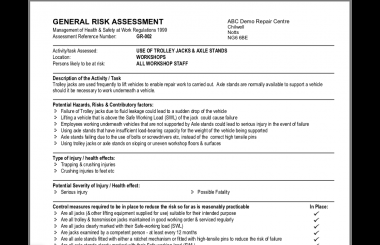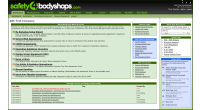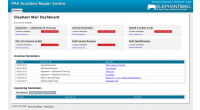Safety4Bodyshops.com
Safety4bodyshops.com is a dynamic Health & Safety ‘interactive’ Management system designed specifically for Accident Repair Centres and Body repair workshops.


Featured Software
-
Safety4Bodyshops.com
Safety4bodyshops.com is a dynamic Health & Safety ‘interactive’ Management system designed specifically for Accident Repair Centres and Body repair workshops.
More Information | Login×Login to Safety4Bodyshops.com -
MyElephantmail.com
If all you need is an online reminders with emails Elephant Mail is a simple effective solution. You can send the recurring reminders as emails to one or several people.
More Information | Login×Login to MyElephantmail.com
Home
Isocyanate training every 5 years now mandatory under REACH Regs:
(Registration, Evaluation, Authorisation and Restriction of Chemicals)
Under both EU and UK REACH regulations, REACH Restriction 2020/1149/EU, the continued use of coatings containing Diisocyanates, requires all personnel handling these products to complete a training course. Beginning on August 24, 2023, any user of diisocyanate with a concentration over 0.1 percent - either the staff of the user or self-employed people - must complete and document the completion of the training. If an employee does not comply with this obligatory training, they will no longer be allowed to work with diisocyanates.
What does this mean?
All employees that either use or handle any products that contain 0.1% of di-isocyanate must now complete an online di-isocyanate training course, the certificate to show that they have completed the course must be kept on file. The training must be carried out every 5 years.
Which products contain di-isocyanates?
- 2K primers, fillers, lacquers etc when mixed with the isocyanate hardener
- PU sealers
- Some adhesives
- Foam insulation
(Check the product Safety Data Sheet)
Which employees require the training?
- Paint staff - inc: painters, paint-mixing staff & preppers
- MET staff
- Panel staff
- Anyone else who uses any of the products listed above
Who supplies the online training course?
An online training course has been designed and put together by several european agencies - Access to the course should be communicated throughout the product supply chain and it’s the responsibility of the suppliers selling the substances and mixtures on the market to ensure that training courses are available to the end-users of such substances or mixtures.
It is the obligation of the employer (in this case the Bodyshop) that their employees are being trained.
How can you access the online training course?
You can access the relevant online training course using the links below.
1) Paint Spraying in a Ventilated Booth
2) Application of adhesives and sealants
---------------------------------------------------------------------------------
HSE isocyanates awareness campaign has started! - Targeted inspections of Bodyshops starts October 1st.
HSE inspectors will visit motor vehicle repair businesses from October to check protection measures against isocyanate exposure, the leading cause of occupational asthma in the UK
Inspectors will focus on ensuring effective controls, procedures and health monitoring are in place. Many skilled vehicle paint sprayers develop this life-changing disease each year, forcing them to leave their profession permanently.
Employers must prevent or control worker exposure to isocyanates through effective control measures and arrange regular health surveillance and biological monitoring.
There are 3 critical control measures where motor vehicle repair businesses commonly fall down on compliance:
- proper spray booth ventilation with adequate extraction systems
- correct respiratory protection equipment - workers must use air-fed breathing apparatus
- safe clearance procedures with clearly displayed measurable clearance times
Health checks are essential:
Under COSHH regulations, employers must also arrange regular health surveillance and biological monitoring for workers exposed to isocyanates. Health surveillance involves regular health checks to detect early signs of occupational asthma, whilst biological monitoring - a simple urine test - checks that control measures are working effectively.
Biological monitoring is a quick and cost-effective way to give sprayers, employers and HSE confidence that spraying is being done safely. It can detect exposure even when control measures appear to be working properly.
'Serious gaps' found in protecting workers from excessive noise
HSE's most recent inspection campaign identified significant failings in workplace hearing protection, with issues in employee training and equipment management.
Key findings showed:
- 75% of employees lacked knowledge about how to store, check or report faults about hearing protection
- 63% had not received guidance on continuous wearing during noise exposure
- 80% received no instruction on proper wearing techniques
Stress Awareness April 2024
April marks Stress Awareness Month 2025, a time for you to take charge of your wellbeing and discover effective ways to manage stress.
Many people still don’t realise that it’s a legal duty to include work-related stress in risk assessments. You can help change that during stress awareness week by supporting HSE’s Working Minds campaign.
The campaign helps raise awareness that all employers are required by law to prevent work-related stress and support good mental health by doing a risk assessment and acting on it.
The campaign helps raise awareness that all employers are required by law to prevent work-related stress and support good mental health by doing a risk assessment and acting on it.
You could:
- talk about it at your next one-to-one with a staff member
- bring it up at a team meeting
- encourage others to do our free bitesize online learning
- download and share resources, such as our one-page summary of support, a campaign poster and social media graphics, with your colleagues and networks
- sign up to the monthly campaign ebulletin for updates and new resources
Recognise the signs
Stress affects people differently.
What impacts one person may not impact another, but signs of stress in a team can include arguments, higher staff turnover, more sickness absence or decreased performance.
Get to the root cause
Try looking for common themes that may need addressing. If you spot a problem or something that might be bubbling, do something about it that will address the root cause.
For example, if someone is struggling with too much workload, consider how that work is allocated or prioritised.
- find out more about the 6 main causes of stress and ideas to tackle them in the Talking Toolkit
- HSE’s Stress Indicator Tool is an online survey available for free for up to 50 employees
Make a difference
Help reach as many workplaces as possible by sharing information on work-related stress.
Find out more at HSE's website, which has advice and guidance on stress and mental health at work.
_______________________________________________________________________________
Risks & Safe Working with Electric and hybrid vehicles - HSE Info:
Introduction:
With the growth in environmental awareness, the use of electric and hybrid vehicles (E&HVs) is increasing. The recovery, repair, and maintenance of these vehicles outside the manufacturers and franchised dealership networks is increasing. This webpage is aimed at people working with these vehicles in the motor vehicle repair and roadside recovery industries and also the emergency services.
[These vehicles are also referred to as a Battery Electric Vehicle (BEV), Hybrid Electric Vehicle (HEV) and Plug-In Hybrid Electric Vehicles (PHEV).]
Background
People in the motor vehicle repair and recovery industry are now more likely to come across E&HVs and as a result need to be aware of the additional hazards they may be exposed to when working with these vehicles. They may also need to develop a wider range of skills and knowledge and have access to specialist tools and equipment in order to be able to work safely.
Voltages present in E&HVs are significantly higher (currently up to 650 Volts direct current (dc)) than those used in other vehicles (12/24 Volts dc). In dry conditions, accidental contact with parts that are live at voltages above 110 Volts dc can be fatal. For E&HVs dc voltages between 60 and 1500 Volts are referred to as 'high voltage'. This terminology is used in this guidance although high voltage is defined differently in other industry sectors.
Battery systems may contain chemicals that can be harmful if released. They also store significant amounts of energy that can give rise to explosion if not dealt with correctly.
There are substantial differences in the designs of E&HVs from different manufacturers. Having information specific to the manufacturer and the vehicle being worked on is important in identifying what actions are necessary to work safely.
Types of vehicle:
Electric vehicles
Electric vehicles use a large capacity battery and electric motor(s) to drive the vehicle. The battery needs to be charged from the electricity supply network when the vehicle is not in use although some energy may be recovered during braking.
Hybrid vehicles
Hybrid vehicles typically have two sources of energy, an internal combustion engine using either diesel or petrol for fuel and a battery. Hybrid vehicles will use the two sources of power automatically and may use both simultaneously. The internal combustion engine and energy recovered from the vehicle braking systems are used to charge the battery.
A plug-in hybrid vehicle can have its battery charged directly from the electrical supply network.
Risks of working with E&HVs
E&HVs introduce hazards into the workplace in addition to those normally associated with the repair and maintenance of vehicles, roadside recovery and other vehicle related activities. These include:
- the presence of high voltage components and cabling capable of delivering a fatal electric shock.
- the storage of electrical energy with the potential to cause explosion or fire.
- components that may retain a dangerous voltage even when a vehicle is switched off.
- electric motors or the vehicle itself that may move unexpectedly due to magnetic forces within the motors.
- manual handling risks associated with battery replacement.
- the potential for the release of explosive gases and harmful liquids if batteries are damaged or incorrectly modified.
- the possibility of people being unaware of vehicles moving as when electrically driven they are silent in operation.
- the potential for the electrical systems on the vehicle to affect medical devices such as pacemakers.
Safe Working with E&HVs
Additional skills and training will be necessary to allow people to work safely with E&HVs. The levels of competency required will vary greatly and are dependent on the type of work that people are expected to do. For example, an awareness of the additional risks is likely to be all that is required for people who undertake vehicle sales or valeting. People involved in vehicle repair and maintenance however, are likely to need a much greater level of competence in order to work on these types of vehicle safely. Specific training with qualifications awarded by organisations such as IMI Awards is available.
Four categories of work have been identified. These are:
- Valeting, sales and other lower risk activities
- Incident response including emergency services and vehicle recovery
- Maintenance and repair excluding high voltage electrical systems
- Working on high voltage electrical systems
These categories are outlined below with the suggested primary controls.
Valeting, sales and other lower risk activities:
Remote operation keys that only need to be close to the vehicle for the vehicle to be powered up should be kept away from vehicles. This is to prevent the vehicle from accidentally moving.
People who move these vehicles around the workplace should be aware that others may not hear it approaching them. Similarly, people who work around E&HVs should be aware that they may move without warning.
Pressure washing has the potential to damage high voltage electrical components and cables. High voltage cables are usually coloured orange. Refer to guidance from manufacturers before valeting in any under body areas including the engine bay.
Remote operation keys that only need to be close to the vehicle for the vehicle to be powered up should be kept away from vehicles. This is to prevent the vehicle from accidentally moving.
People who move these vehicles around the workplace should be aware that others may not hear it approaching them. Similarly, people who work around E&HVs should be aware that they may move without warning.
Incident response including emergency services and vehicle recovery:
Vehicles should be visually checked for signs of damage to high voltage electrical components or cabling (usually coloured orange). Consider whether the integrity of the battery is likely to have been compromised. Shorting or loss of coolant may present ignition sources in the event of fuel spillage. If the vehicle is damaged or faulty, and if safe to do so, isolate the high voltage battery system using the isolation device on the vehicle. Refer to manufacturer's instructions for guidance.
During any recovery onto a recovery vehicle, the remote operation key should be removed to a suitable distance and the standard 12/24v battery disconnected to prevent the vehicle from being activated/started.
Have access to reliable sources of information for specific vehicle types. For example mobile data terminals used by fire and rescue services or by reference to manufacturer's data.
Avoid towing E&HV vehicles unless it can be determined that it is safe to do so. Dangerous voltages can be generated by movement of the drive wheels.
Maintenance and repair excluding high voltage electrical systems:
Refer to vehicle specific sources of information from the manufacturer and trade bodies to identify precautions necessary to prevent danger.
Remote operation keys should be kept away from the vehicle to prevent any accidental operation of electrical systems and accidental movement of the vehicle. Keys should be locked away with access controlled by the person working on the vehicle. If the key is required during the work the person working on the vehicle should check that the vehicle is in a safe condition before the key is retrieved.
Visually check the vehicle for signs of damage to high voltage cabling (usually coloured orange) or electrical components before starting any work on the vehicle.
Unless a specific task requires the vehicle to be energised always isolate or disconnect the high voltage battery in accordance with manufacturer's instructions.
Determine the locations of high voltage cables before carrying out tasks such as panel replacement, cutting or welding. Take appropriate precautions to prevent them from being damaged.
Refer to vehicle specific sources of information from the manufacturer and trade bodies to identify precautions necessary to prevent danger.
Remote operation keys should be kept away from the vehicle to prevent any accidental operation of electrical systems and accidental movement of the vehicle. Keys should be locked away with access controlled by the person working on the vehicle. If the key is required during the work the person working on the vehicle should check that the vehicle is in a safe condition before the key is retrieved.
Visually check the vehicle for signs of damage to high voltage cabling (usually coloured orange) or electrical components before starting any work on the vehicle.
Unless a specific task requires the vehicle to be energised always isolate or disconnect the high voltage battery in accordance with manufacturer's instructions.
Working on high voltage electrical systems:
Refer to vehicle specific sources of information from the manufacturer (and trade bodies) to identify precautions you need to implement which are necessary to prevent danger.
Remote operation keys should always be kept away from the vehicle to prevent any accidental operation of electrical systems and accidental movement of the vehicle. Keys should be locked away with access controlled by the person working on the vehicle. If the key is required during the work the person working on the vehicle should check that the vehicle is in a safe condition before the key is retrieved.
Visually check the vehicle for signs of damage to high voltage electrical components or cabling (usually coloured orange).
High voltage systems should be isolated (that is the power disconnected and secured such that it cannot be inadvertently switched back on) and proven dead by testing before any work is undertaken. Always isolate and lock off the source of electricity and in accordance with manufacturer's instructions. You must always test and prove that any high voltage cable or electrical component is dead prior to carrying out any work on it.
Even when isolated, vehicle batteries and other components may still contain large amounts of energy and retain a high voltage. Only suitable tools and test equipment should be used. These may include electrically insulated tools and test equipment compliant with GS38.
Some electronic components may store dangerous amounts of electricity even when the vehicle is off and the battery isolated. Refer to manufacturers data on how to discharge stored energy.
There may be circumstances (eg after collision damage) where it has not been possible to fully isolate the high voltage electrical systems and to discharge the stored energy in the system. Refer to the manufacturer's instructions about what controls measures should be implemented before attempting to carry out further remedial work.
Battery packs are susceptible to high temperatures. The vehicle will typically be labelled advising of its maximum temperature and this should be considered when carrying operations such as painting where booth temperatures may exceed this limit. Measures should be implemented to alleviate any potential risks eg by removing the batteries or by providing insulation to limit any temperature increase in the batteries.
Working on live electrical equipment should only be considered when there is no other way for work to be undertaken. Even then it should only be considered if it is both reasonable and safe to do so. You should consider the risks for working on this live equipment and implement suitable precautions including, as a final measure, the use of personal protective equipment (PPE). Refer to manufacturer's instructions for precautions when working live, including their PPE requirements.
It may be necessary to locate the vehicle within an area that can be secured such that people who could be put at risk are not able to approach the vehicle. Warning signs should be used to make people aware of the dangers.
See Institute of the Motor Industry Awards for further information on qualifications and training.
Information courtesy of HSE. Link to HSE website: https://www.hse.gov.uk/mvr/topics/electric-hybrid.htm#safe
Isocyanate training every 5 years now mandatory under REACH Regs:
(Registration, Evaluation, Authorisation and Restriction of Chemicals)
Under both EU and UK REACH regulations, REACH Restriction 2020/1149/EU, the continued use of coatings containing Diisocyanates, requires all personnel handling these products to complete a training course. Beginning on August 24, 2023, any user of diisocyanate with a concentration over 0.1 percent - either the staff of the user or self-employed people - must complete and document the completion of the training. If an employee does not comply with this obligatory training, they will no longer be allowed to work with diisocyanates.
What does this mean?
All employees that either use or handle any products that contain 0.1% of di-isocyanate must now complete an online di-isocyanate training course, the certificate to show that they have completed the course must be kept on file. The training must be carried out every 5 years.
Which products contain di-isocyanates?
- 2K primers, fillers, lacquers etc when mixed with the isocyanate hardener
- PU sealers
- Some adhesives
- Foam insulation
(Check the product Safety Data Sheet)
Which employees require the training?
- Paint staff - inc: painters, paint-mixing staff & preppers
- MET staff
- Panel staff
Who supplies the online training course?
The online training course has been designed and put together by several european agencies - Access to the course should be communicated throughout the product supply chain and it’s the responsibility of the suppliers selling the substances and mixtures on the market to ensure that training courses are available to the end-users of such substances or mixtures.
It is the obligation of the employer (in this case the Bodyshop) that their employees are being trained.
How can you access the online training course?
Your product suppliers should provide you with information regarding the mandatory di-isocyanate training and how to access it however, we have provided a link to the online training below.
https://www.safeusediisocyanates.eu/
---------------------------------------------------------------------------------
Coronavirus
The government has warned that up to a fifth of the workforce may be off sick during the peak of a coronavirus epidemic in the UK. Plans to contain Coronavirus if it spreads have been set out by the UK Government
See latest Government advice for Employers....
Safety4bodyshops has been used to great success by many bodyshops for the last 11 years. Whether you are a Bodyshop owner/manager who wants to manage your company's health & safety issues or a Consultant wishing to use the system to manage your clients bodyshops, Safety4bodyshops.com will make H & S management an 'easy' task.
Download a free copy of 'Heath & Safety in Vehicle Repair'
Testimonials
I have to say that Safety4Bodyshops is the best H & S system I have come across for years and well under publicised ~ Stuart Cameron of Fix Auto Penzance
"I find the Safety4bodyshops system so easy to use. I did'nt know much about health & safety in a Bodyshop but safety4bodyshops has made it so easy. The Risk Assessments are simple & the email reminders make sure we are right up to date with everything and so don't have to worry about any suprise visits from the HSE or EPA. We even get professional advice anytime we need it. I recommend Safety4bodyshops.com to any Bodyshop owner who wants to manage their Health & safety but does not want to pay out for expensive consultants. ~ Julia Lane of B & K Accident Repair Centre Ltd - Coventry
"The Safety4bodyshops site is of great benifit to our Company. It is simple to use & navigation around the site is so easy. There are lots of useful features to use which assists in the effective management of health & safety in our busy bodyshop" ~ Roland Davis of Alton Cars



